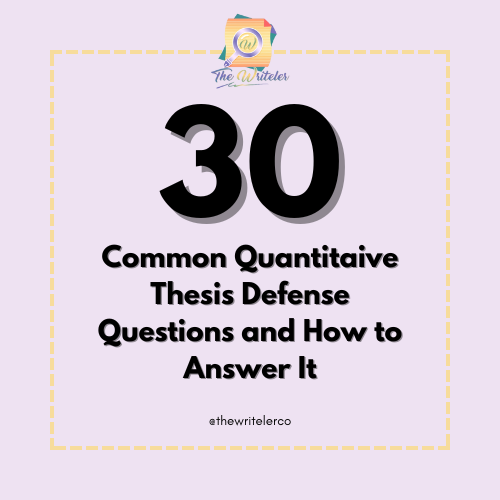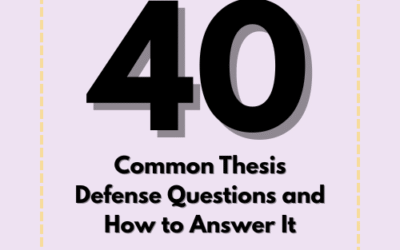Facing your thesis defense can feel intimidating, but being well-prepared can turn it into a confident, rewarding experience. In this guide, we’ve compiled 30 of the most common questions asked during undergraduate thesis defenses in education, along with sample answers to help you craft your own responses. You’ll also find bonus tips to stay composed, handle tricky questions, and leave a lasting impression on your panel.
Question 1: Can you summarize your research study?
My study examined the effect of peer tutoring on middle school students’ math achievement. Specifically, I implemented a peer tutoring program and measured math test scores to see if the tutored group outperformed a control group. This quantitative study used a quasi-experimental design with pre- and post-tests to assess learning gains. The results showed a significant improvement in math achievement for students who participated in peer tutoring compared to those who did not.
Question 2: What motivated you to choose this research topic?
My interest in this topic was sparked by observing many students struggle with math while others thrived when working together. I wanted to explore whether a structured peer tutoring approach could systematically improve math achievement. There was also a clear gap in the literature in our local context about peer-assisted learning strategies, which motivated me to contribute new data. Additionally, my passion for collaborative learning methods made this topic a natural choice for me to investigate academically.
Question 3: What problem or gap does your study address?
My study addresses the problem of persistently low math achievement among students and the need for effective interventions to boost their performance. The specific gap I tackled was the lack of empirical evidence on the effectiveness of peer tutoring in our local school context. While prior research suggested peer tutoring can be beneficial, few studies had quantified its impact on math outcomes in a similar setting. My work provides data to fill this gap by evaluating whether a peer tutoring program can significantly improve math test scores.
Question 4: What are the objectives or research questions of your study?
The main objective of my study was to determine if peer tutoring has a significant effect on students’ math achievement. I formulated this as a research question asking whether students who participate in a peer tutoring program perform better on math assessments than those who do not. In addition, I aimed to explore any differences in improvement between high-achieving and low-achieving students within the tutoring group. Overall, the study’s goals were centered on evaluating the impact of peer tutoring and understanding its potential benefits across different student groups.
Question 5: What were your hypotheses?
I hypothesized that students who receive peer tutoring would show significantly higher improvement in math test scores compared to students who do not receive peer tutoring. Additionally, I expected that lower-performing students would benefit the most from the peer tutoring intervention, showing greater gains than their higher-performing peers. These hypotheses were based on educational theories of collaborative learning, which suggest that peer interaction can reinforce understanding and help struggling students catch up.
Question 6: What theoretical or conceptual framework guided your research?
My research was guided by social constructivist learning theory, which emphasizes the value of interactions in learning. In particular, I drew on Vygotsky’s concept of the Zone of Proximal Development (ZPD), which suggests that students can perform at higher levels with appropriate support or scaffolding from peers or mentors. This framework supported my belief that peer tutoring would provide the scaffolding needed for students to improve in math. Additionally, I reviewed previous studies on peer tutoring and collaborative learning, which provided an empirical foundation and context for my work.
Question 7: What is the significance or contribution of your study to the field of education?
My study contributes to the field by providing empirical evidence on an accessible intervention to improve math achievement. It offers quantitative data demonstrating that a peer tutoring program can significantly benefit student learning in a real classroom setting. This is important for educators and policymakers because it supports an affordable, practical strategy to address low performance in math. Furthermore, it adds to the academic literature by confirming and extending findings from prior studies in a new context, thereby strengthening the case for peer-assisted learning approaches.
Question 8: Can you describe your research design and methodology?
I used a quantitative quasi-experimental research design for this study. Specifically, I implemented a pre-test/post-test control group design: one group of students participated in the peer tutoring program while a comparable group did not. Both groups took a math test before and after the intervention period. This design allowed me to measure the effect of the peer tutoring by comparing the gains in test scores between the tutored group and the control group, establishing a clear link between the intervention and any observed improvement.
Question 9: Why did you choose this particular methodology or design?
I chose this quasi-experimental approach because it was the most practical and rigorous way to test my research question in an authentic school setting. Randomized controlled trials were not feasible in our context, so I used intact classes as control and experimental groups while still employing pre- and post-testing to ensure comparability. A quantitative method was appropriate since I needed to measure learning outcomes in a numeric way and determine if any observed differences were statistically significant. Overall, this design balanced control and realism, allowing me to draw meaningful conclusions about the impact of peer tutoring.
Question 10: What instruments or tools did you use to collect data, and how did you ensure they were valid and reliable?
I collected data using a standardized math achievement test that was administered to both groups before and after the tutoring program. I chose a standardized test because it has established validity and reliability. It is aligned with the curriculum and had been used in previous studies, which gave me confidence in its accuracy. For further validation, I had experts review any additional test items to ensure they covered the intended skills. I also conducted a pilot test with a small group of students, which confirmed that the instrument was clear and reliable.
Question 11: Can you tell us about your sample and sampling technique?
My sample consisted of middle school students from two classes at the same school. One class (with 30 students) served as the peer tutoring group, and the other class (28 students) served as the control group. I used a convenience sampling approach since I worked with classes that were already formed and available to me. However, I made sure the two classes were similar in terms of grade level and prior math performance to make the comparison as fair as possible.
Question 12: What steps did you take to ensure your findings are valid and reliable?
I took several steps to ensure valid and reliable findings. For internal validity, I used a control group and administered a pre-test to account for any initial differences between groups, so any gains could be attributed to the peer tutoring intervention. I kept conditions consistent for both groups (for example, both groups took the same tests under the same conditions) to ensure fairness. To enhance reliability, I used the same testing procedures for each administration and double-checked data entry and scoring. By carefully controlling variables and using standardized measures, I am confident that the results accurately reflect the effect of the peer tutoring program.
Question 13: How did you analyze the data?
I analyzed the data using statistical methods appropriate for comparing the two groups’ test scores. First, I computed descriptive statistics to summarize the performance of each group before and after the intervention. Then, to test my hypotheses, I performed paired t-tests within each group to see if there were significant improvements over time. I also used an independent-samples t-test to compare the score gains between the peer tutoring group and the control group. Additionally, I checked assumptions like normality before running these tests to ensure the analysis was valid.
Question 14: What are the main findings of your study?
My study found that the peer tutoring program led to a clear improvement in math performance. Specifically, the students who participated in peer tutoring showed a statistically significant increase in their math test scores from pre-test to post-test. In contrast, the control group without tutoring did not show a significant improvement. Moreover, when comparing the two groups, the tutored students had significantly higher gains in scores than the control students, indicating that the peer tutoring was effective.
Question 15: How do these findings answer your research questions or support your hypotheses?
The findings directly answer my research question by showing that peer tutoring does have a positive effect on student math achievement. The significant improvements in the tutored group, along with the lack of similar gains in the control group, support my primary hypothesis that tutored students would outperform those without tutoring. The results confirmed that the tutoring intervention was effective, as hypothesized. Additionally, the data indicated that lower-performing students improved substantially, which aligns with my expectation that those who started behind would benefit greatly from the peer

Question 16: Were there any unexpected results?
For the most part, the results aligned with my expectations, but I did observe one unexpected finding. While I anticipated that lower-performing students would benefit the most, I found that even the higher-achieving students in the peer tutoring group made notable gains, more than I initially expected. This was a pleasant surprise, suggesting that peer tutoring can be advantageous for all ability levels, not just those who were struggling. It reinforced the idea that collaborative learning has broad benefits across the spectrum of student performance.
Question 17: How do your results compare to existing literature or previous studies?
My results are largely consistent with findings from previous studies on peer tutoring. Like earlier research, I found that peer tutoring can lead to significant improvements in academic performance. This consistency strengthens confidence in the existing research and shows that the positive effects of peer tutoring generalize to my study context as well. I did not encounter any major contradictions with existing literature; rather, my work adds a local evidence base that aligns with the broader consensus that peer-assisted learning is beneficial.
Question 18: What are the implications of your findings for educational practice or policy?
My findings have practical implications for how we approach math education. The clear benefits observed from peer tutoring suggest that schools should consider incorporating structured peer tutoring programs as a supplement to regular instruction. For teachers, this implies that facilitating student-to-student support can boost learning outcomes, especially in challenging subjects such as math. For policymakers and school administrators, the results provide evidence that investing time and resources in peer tutoring could be an effective strategy to improve academic achievement without requiring major new curriculum overhauls.
Question 19: What are the theoretical implications of your study?
Theoretically, my study reinforces the principles of collaborative learning and social constructivism. The success of the peer tutoring intervention supports Vygotsky’s idea that students can extend their learning through social interaction and scaffolding within their Zone of Proximal Development. By demonstrating these effects empirically, my research adds evidence to educational theories that emphasize the importance of peer-assisted learning. It suggests that the mechanisms proposed by those theories (such as the value of dialogue and scaffolding between peers) do operate in real classroom settings, thereby strengthening the theoretical understanding of how peer collaboration facilitates learning.
Question 20: What recommendations do you have for educators or practitioners based on your results?
For educators, I recommend implementing structured peer tutoring sessions in their classrooms, especially for subjects where students typically struggle. Teachers could train student tutors and provide them with guidance, as this study indicates such efforts can pay off in better student performance. It’s also advisable for teachers to monitor and support the tutoring sessions to ensure they are effective and that both tutors and tutees are benefiting. Overall, integrating peer-assisted learning strategies as a complement to traditional teaching methods could help boost achievement.
Question 21: What recommendations do you have for future research?
For future research, I suggest exploring peer tutoring in different contexts and with larger sample sizes. For example, researchers could investigate whether these positive effects hold true for other subjects such as science or languages, or at different educational levels like elementary and high school. It would also be valuable to examine long-term effects by following students over time to see if the improvements in achievement persist. Additionally, future studies might incorporate qualitative elements, like interviews or classroom observations, to better understand the dynamics of peer tutoring and identify what specific interactions make it effective.
Question 22: What were the limitations of your study?
Like any study, mine had a few limitations. One major limitation was the sample size and scope: I only worked with two classes in one school, which means the findings may not generalize to all student populations or different settings. Another limitation was the quasi-experimental design without random assignment, so even though I used a control group, there could be pre-existing differences between the groups that I couldn’t completely eliminate. Additionally, the study was conducted over a relatively short period (several weeks of tutoring), so it captures only short-term effects and might not reflect long-term impacts.
Question 23: How did you address or mitigate these limitations?
I took steps to mitigate the limitations as much as possible. For the small sample and single-school scope, I was careful not to overgeneralize my conclusions, instead framing them as evidence from a specific context. To compensate for the lack of random assignment, I used a pre-test and selected classes that were similar in academic level, which helped ensure the groups were comparable at the start of the study. I also acknowledged these limitations in my thesis and made recommendations for future research (such as involving more schools and conducting long-term studies) to address them beyond what I could accomplish in this project.
Question 24: If you were to conduct this study again, what would you do differently?
If I could do the study again, I would make a few changes to strengthen it. First, I would aim for a larger and more diverse sample, perhaps involving multiple schools, to increase the generalizability of the results. I would also try to implement random assignment to the extent possible, or at least use matched pairs of students, to further improve the internal validity. Additionally, I would consider extending the duration of the peer tutoring program and adding a follow-up test months later to examine long-term effects. Finally, I might incorporate qualitative measures, such as interviews or observations, to gain deeper insights into how the peer tutoring process works.
Question 25: Did you encounter any challenges during your research, and how did you overcome them?
Yes, I did encounter a few challenges. One of the main challenges was scheduling the peer tutoring sessions without disrupting regular classes. I overcame this by coordinating closely with teachers and conducting the tutoring during lunch breaks or after school, ensuring that both tutors and tutees could participate consistently. Another challenge was keeping the students motivated throughout the program, and I addressed this by setting clear goals and occasionally providing small incentives and feedback to maintain their engagement. Overall, being flexible and proactive in problem-solving helped me complete the study successfully despite these hurdles.
Question 26: How did you ensure ethical considerations were addressed in your study?
I made sure to follow all ethical guidelines for research with student participants, obtaining approval from the school administration and the university’s ethics committee before starting the study. Parental consent and student assent were obtained for all participants, and I ensured they understood that participation was voluntary and that they could withdraw at any time. I maintained confidentiality by anonymizing the data (no individual student is identified in my thesis or results). Additionally, I was mindful to ensure that the tutoring program posed no harm, as it was designed to support learning. After the study, I provided extra resources to the control group so they would not be disadvantaged by not receiving the tutoring during the research.
Question 27: How did you define key terms or variables in your research?
In my thesis, I provided clear operational definitions for all the key terms. For example, I defined “peer tutoring” as a structured program where students in the same grade level are paired such that one acts as a tutor, helping the other with math exercises under teacher guidance. “Math achievement” was defined by performance on a standardized math test aligned with the curriculum, measured through the scores students obtained on the pre-test and post-test. By explicitly defining these concepts, I ensured that readers would understand exactly what was being measured and implemented in my study.
Question 28: What makes your study original or what is the novelty of your work?
My study offers originality in a couple of ways, even though the topic of peer tutoring has been studied before. First, it was conducted in a context (our local school setting) where little to no prior data on peer tutoring existed, thus providing new evidence for this community. Second, I examined how students of different initial ability levels benefited from the tutoring, which adds nuance to the typical findings of peer tutoring research. In doing so, my work not only replicates a known educational strategy in a new environment but also introduces insights about differential effects on learners that have not been thoroughly explored before.
Question 29: What do you consider the key strengths of your study?
My study has several strengths. One major strength is the rigorous design: by including both a control group and pre- and post-tests, the study provides strong evidence for a causal effect of the peer tutoring program on math achievement. Another strength is the practical relevance of the research: it was conducted in a real classroom setting, which means the findings are highly applicable to actual teaching practice. Additionally, the use of a standardized, validated test as a measurement tool adds credibility to the results. These strengths give me confidence that the conclusions drawn from the study are solid and meaningful for the field.
Question 30: What is the key message or takeaway from your research?
The main takeaway from my research is that peer tutoring can be a powerful tool to improve students’ learning in mathematics. In essence, students are not just learners but can also be teachers to each other, and this mutual support can significantly boost academic achievement. By implementing structured peer tutoring, schools can tap into an underused resource, namely students’ ability to help one another, to raise performance. Overall, my study shows that fostering collaboration among students can lead to meaningful educational gains.
The Writeler Co. is here to support students and professionals who are juggling research with work, life, and business. Whether you’re writing a thesis, capstone, or dissertation for your master’s or Ph.D., we help you efficiently navigate the research journey — from brainstorming to proofreading.
📩 Message us today to get started.
📚 Let’s turn your research idea into a powerful paper.





0 Comments